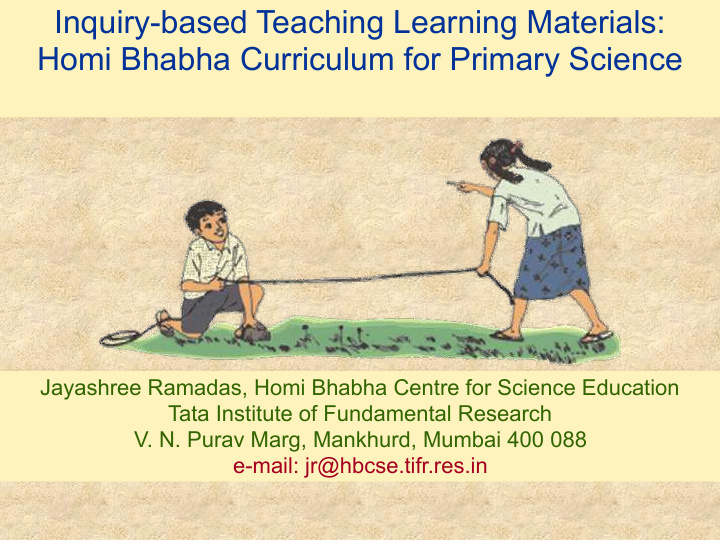



Inquiry-based Teaching Learning Materials: Homi Bhabha Curriculum for Primary Science Jayashree Ramadas, Homi Bhabha Centre for Science Education Tata Institute of Fundamental Research V. N. Purav Marg, Mankhurd, Mumbai 400 088 e-mail: jr@hbcse.tifr.res.in
HOMI BHABHA CURRICULUM FOR PRIMARY SCIENCE SMALL SCIENCE Teacher’s Book for classes I and II Teacher’s Book, TextBook and WorkBook for classes III, IV and V
HOMI BHABHA CURRICULUM FOR PRIMARY SCIENCE SMALL SCIENCE HIGHLIGHTS OF THE CURRICULUM Try planting different dals, grains of rice, sago. Do they sprout? Make your own guess why they did not sprout? ➢ Inquiry-based 3. Watch closely! Which of the seeds sprouted first? Did you see the tiny root going into the soil? Which plants grew the tallest? ➢ Shaped by classroom trials
HOMI BHABHA CURRICULUM FOR PRIMARY SCIENCE SMALL SCIENCE HIGHLIGHTS OF THE CURRICULUM ➢ Draws on research and field-work in rural and urban areas
HOMI BHABHA CURRICULUM FOR PRIMARY SCIENCE SMALL SCIENCE HIGHLIGHTS OF THE CURRICULUM ➢ Cognitively appropriate ~ Organized concrete experiences ~ Contextualization of content ~ Age-appropriate process skills ~ Collaborative learning situations ~ Students' conceptions are addressed
HOMI BHABHA CURRICULUM FOR PRIMARY SCIENCE SMALL SCIENCE HIGHLIGHTS OF THE CURRICULUM Assessed aims of the curriculum are skills of ➢ “learning how to learn” ~ Observation ~ Design, drawing and construction skills ~ Measurement and quantitative thinking ~ Language development for and through science
HOMI BHABHA CURRICULUM FOR PRIMARY SCIENCE SMALL SCIENCE HIGHLIGHTS OF THE CURRICULUM ➢ Environmental concerns permeate content Food Where our food comes from What happens to it in the body What is thrown out - The parts we throw away - Who eats them? Microbes, Garbage, Sewage disposal ➢ Sensitivity to gender, culture, class ➢ Low cost of implementation ~ Material cost ~ Production cost of books
HOMI BHABHA CURRICULUM FOR PRIMARY SCIENCE SMALL SCIENCE HIGHLIGHTS OF THE CURRICULUM Topics and themes
HOMI BHABHA CURRICULUM FOR PRIMARY SCIENCE SMALL SCIENCE CURRENT USAGE ➢ 20 schools have adopted the curriculum ➢ About 100 schools/ NGOs/ States are using it as reference material
HOMI BHABHA CURRICULUM FOR PRIMARY SCIENCE SMALL SCIENCE LANGUAGE AND MATHS IN PRIMARY SCIENCE ➢ Language and Mathematics are core subjects in primary school. ➢ Yet basic literacy and numeracy objectives are not met (Yash Pal Committee, 1993). ➢ Language used in textbooks and schools is highly formal and Sanskritised. Regional languages are stigmatised (Prashika, 1994).
HOMI BHABHA CURRICULUM FOR PRIMARY SCIENCE SMALL SCIENCE LANGUAGE AND MATHS IN PRIMARY SCIENCE ➢ Language of science textbooks is structurally more complex than that of language textbooks. Simplifying not only helps comprehension, it enhances teacher-pupil interaction (HBCSE, 1970s). ➢ Students in the Marathi medium show better comprehension and originality in science than those in comparable English medium schools (HBCSE, 1970s).
HOMI BHABHA CURRICULUM FOR PRIMARY SCIENCE SMALL SCIENCE LANGUAGE AND MATHS IN PRIMARY SCIENCE ➢ Rural and tribal students have richer experiences of the natural environment. But lacking systematisation and clear expression, these experiences are easily de-valued. They do not contribute to school learning (HBCSE, mid-1990s).
HOMI BHABHA CURRICULUM FOR PRIMARY SCIENCE SMALL SCIENCE LANGUAGE AND MATHS IN PRIMARY SCIENCE ➢ Practical work in science classrooms does not by itself lead to conceptual change: data collection and analysis must be supported by articulation and reflection (Research of 1980s). ➢ Language and mathematics as tools to systematise and to interpret ones experiences.
HOMI BHABHA CURRICULUM FOR PRIMARY SCIENCE SMALL SCIENCE LANGUAGE IN “SMALL SCIENCE” ➢ Language for fun It bubbles, it blows It creeps and it flows ~ Stories and poems It whistles, it sings Lifts bird on their wings ~ Word play Think of some ‘sound words’ … bang! Trrnng hum squeak plop sshrooookh
HOMI BHABHA CURRICULUM FOR PRIMARY SCIENCE SMALL SCIENCE LANGUAGE IN “SMALL SCIENCE” ➢ Oral and written expression ~ Recounting experiences ~ Asking questions ~ Critical thinking, argument, debate Talk and write Think of the air you breathe every day. Is it clean or dirty? Why do you think so? What things make your air either dirty or clean? What can you do to get clean air?
HOMI BHABHA CURRICULUM FOR PRIMARY SCIENCE SMALL SCIENCE LANGUAGE IN “SMALL SCIENCE” ➢ Reading comprehension ~ Following instructions for activities ~ Question and answers ~ New language elements and structures (eg. action words, parts of body) But … ➢ Teachers’ interpretation may differ
HOMI BHABHA CURRICULUM FOR PRIMARY SCIENCE SMALL SCIENCE MATHS IN “SMALL SCIENCE” ➢ Arithmetic Count the number of plants and animals you see: ~ Watch for numbers * in summer ~ Count * when the rains begin ~ Seriate ~ Measure Calendar activities How many? How much? How long? How high? How far?
HOMI BHABHA CURRICULUM FOR PRIMARY SCIENCE SMALL SCIENCE MATHS IN “SMALL SCIENCE” ➢ Graphical reasoning ~ Shapes and sizes East West ~ Picture graphs North (thermometers) ~ Venn diagrams Rain Sunshine
HOMI BHABHA CURRICULUM FOR PRIMARY SCIENCE SMALL SCIENCE MODES OF DISSEMINATION ➢ As curriculum ➢ As resource in classroom ➢ As resource for curriculum development ➢ Collaboration with States, NGOs, NCERT ➢ To shift perceptions of science teaching among teachers, parents, policy-makers, community
Recommend
More recommend